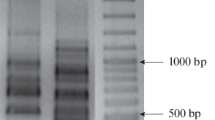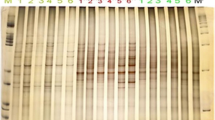Abstract
Biphenyl-utilizing soil bacteria are ubiquitously distributed in the natural environment. They cometabolize a variety of polychlorinated biphenyl (PCB) congeners to chlorobenzoic acids through a 2,3-dioxygenase pathway, or alternatively through a 3,4-dioxygenase system. Thebph genes coding for the metabolism of biphenyl have been cloned from several pseudomonads. The biochemistry and molecular genetics of PCB degradation are reviewed and discussed from the viewpoint of an evolutionary relationship.
Similar content being viewed by others
Abbreviations
- BP:
-
biphenyl
- bph :
-
BP/PCB-degradative gene
- 23DHBP:
-
2,3-dihydroxybiphenyl
- HPDA:
-
2-hydroxy-6-oxo-6-phenylhexa 2,4-dienoic acid
- KF707:
-
P. pseudoalcaligenes strain KF707
- LB400:
-
Pseudomonas sp. strain LB400
- PCB:
-
polychlorinated biphenyls
- Q1:
-
P. paucimobilis strain Q1tod; toluene catabolic gene
References
Abramowicz DA (1990) Aerobic and anaerobic biodegradation of PCBs: a review. Crit. Rev. Biotechnol. 10: 241–251
Adams RH, Huang C-H, Higson FK, Brenner V & Focht DD (1992) Construction of a 3-chlorobiphenyl-utilizing recombinant from an intergenic mating. Appl. Environ. Microbiol. 58: 647–654
Ahmad D, Massa R & Sylvestre M (1990) Cloning and expression of genes involved in 4-chlorobiphenyl transformation byPseudomonas testosteroni: homology to polychlorobiphenyl-degrading genes in other bacteria. Gene 86: 53–61
Ahmed M & Focht DD (1973) Degradation of polychlorinated biphenyls by two species ofAchromobacter. Can. J. Microbiol. 19: 47–52
Aust SD (1990) Degradation of environmental pollutants byPhanerochaete chrysosporium. Microb. Ecol. 20: 197–209
Barton MR & Crawford RL (1988) Novel biotransformation of 4-chlorobiphenyl by aPseudomonas sp. Appl. Environ. Microbiol. 54: 594–595
Bedard DL, Haberl ML, May RJ & Brennan (1987) Evidence for novel mechanisms of polychlorinated biphenyl metabolism inAlcaligenes eutrophus H850. Appl. Environ. Microbiol. 53: 1103–1112
Bedard ML, Unterman R, Bopp LH, Brennan MJ, Haberl ML & Johnson S (1986) Rapid assay for screening and characterizing microorganisms for the ability to degrade polychlorinated biphenyls. Appl. Environ. Microbiol. 51: 761–768
Bedard DL, Wagner RE, Brennan MJ, Haberl ML & Brown JF Jr (1987) Extensive degradation of Aroclors and environmentally transformed polychlorinated biphenyls byAlcaligenes eutrophus H850. Appl. Environ. Microbiol. 53: 1094–1102
Brown JF Jr, Bedard DL, Brennan MJ, Carnahan JC, Feng H & Wagner RE (1987) Polychlorinated biphenyl dechlorination in aquatic sediments. Science 236: 709–712
Etlis LD, Hofmann B, Hecht H-J, Lünsdorf H & Timmis KT (1993) Purification and crystallization of 2,3-dihydroxybiphenyl 1,2-dioxygenase. J. Biol. Chem. 268: 2727–2732
Erickson B & Mondello F (1992) Nucleotide sequencing and transcriptional mapping of the genes encoding biphenyl dioxygenase, a multicomponent polychlorinated biphenyl-degrading enzyme inPseudomonas strain LB400. J. Bacteriol. 174: 2903–2912
—— (1993) Enhanced biodegradation of polychlorinated biphenyls after site-directed mutagenesis of a biphenyl dioxygenase gene. Appl. Environ. Microbiol. 59: 3858–3862
Furukawa K (1982) Microbial degradation of polychlorinated biphenyls. In: Chakrabarty AM (Ed) Biodegradation and Detoxification of Environmental Pollutants (pp 33–57) CRC Press Inc., Boca Raton, Fla
—— (1986) Modification of PCBs by bacteria and other microorganisms. In: Waid J (Ed) PCBs and the Environment (pp 89–99) CRC Press Inc., Boca Raton, Fla
Furukawa K & Arimura N (1987) Purification and properties of 2,3-dihydroxybiphenyl dioxygenase from polychlorinated biphenyl-degradingPseudomonas pseudoalcaligenes andPseudomonas aeruginosa carrying the clonedbphC gene. J. Bacteriol. 169: 924–927
Furukawa K, Hayase N, Taira K & Tomizuka N (1989) Molecular relationship of chromosomal genes encoding biphenyl/polychlorinated biphenyl catabolism: some soil bacteria possess a highly conservedbph operon. J. Bacteriol. 171: 5467–5472
Furukawa K, Hayashida S & Taira K (1991) Gene-specific transposon mutagenesis of the biphenyl/polychlorinated biphenyl-degradation-controllingbph operon in soil bacteria. Gene 98: 21–28
—— (1992) Biochemical and genetic basis for the degradation of polychlorinated biphenyls in soil bacteria. In: Galli E, Silver S & Witholt B (Eds)Pseudomonas: Molecular Biology and Biotechnology (pp 259–267) American Society for Microbiology, Washington DC
Furukawa K, Hirose J, Suyama A, Zaiki T & Hayashida S (1993) Gene components responsible for discrete substrate specificity in the metabolism of biphenyl (bph operon) and toluene (tod operon). J. Bacteriol. 175: 5224–5232
Furukawa K, Matsumura F & Tonomura K (1978)Alcaligenes andAcinetobacter strains capable of degrading polychlorinated biphenyls. Agric. Biol. Chem. 42: 543–548
Furukawa K & Miyazaki T (1986) Cloning of gene cluster encoding biphenyl and chlorobiphenyl degradation inPseudomonas pseudoalcaligenes. J. Bacteriol. 166: 392–398
Furukawa K, Tomizuka N & Kamibayashi A (1979) Effect of chlorine substitution on the bacterial metabolism of various polychlorinated biphenyls. Appl. Environ. Microbiol. 38: 301–310
Furukawa K, Tonomura K & Kamibayashi (1978) Effect of chlorine substitution on the biodegradability of polychlorinated biphenyls. Appl. Environ. Microbiol. 35: 223–227
Gibson DT, Zylstra GT & Chauhan S (1990) Biotransformations catalyzed by toluene dioxygenase fromPseudomonas putida F1. In: Silver S, Chakrabarty AM, Iglewski & Kaplan S (Eds)Pseudomonas: Biotransformation, Pathogenesis, and Evolving Biotechnology (pp 301–310) American Society for Microbiology, Washington, DC
Haddock JD, Nadium LM & Gibson DT (1993) Oxidation of biphenyl by a multicomponent enzyme system fromPseudomonas sp. strain LB400. J. Bacteriol. 175: 401–410
Harayama S & Kok M (1992) Functional and evolutionary relationship among diverse organisms. Annu. Rev. Microbiol. 46: 565–601
Harayama S & Rekik M (1993) Comparison of the nucleotide sequences of the meta-cleavage pathway genes of TOL plasmid pWW0 fromPseudomonas putida with other meta-cleavage genes suggests that both single and multiple nucleotide substitutions contribute to enzyme evolution. Mol. Gen. Genet. 239: 81–89
Hayase N, Taira K & Furukawa K (1990)Pseudomonas putida KF715bphABCD operon encoding biphenyl and polychlorinated biphenyl degradation: cloning, analysis and expression in soil bacteria. J. Bacteriol. 172: 1160–1164
Hickey WJ, Brenner V & Focht DD (1992) Mineralization of 2-chloro- and 2,5-dichlorobiphenyl byPseudomonas sp. strain UCR2. FEMS Microbiol. Lett. 98: 175–180
Higson FK (1992) Microbial degradation of biphenyl and its derivatives. Adv. Appl. Microbiol. 37: 135–164
Hirose J, Suyama A, Hayashida S & Furukawa K (1994) Construction of hybrid biphenyl (bph) and toluene (tod) genes for functional analysis of aromatic ring dioxygenases. Gene 138: 27–33
Hofer B, Eltis LD, Dowling DN & Timmis KN (1993) Genetic analysis of aPseudomonas locus encoding a pathway for biphenyl/polychlorinated biphenyl degradation. Gene 130: 47–55
Khan A & Walia S (1989) Cloning of bacterial genes specifying degradation of 4-chlorobiphenyl fromPseudomonas putida OU83. Appl. Environ. Microbiol. 55: 798–805
Kimbara K, Hashimoto T, Fukuda M, Koana T, Takagi M, Oishi M & Yano K (1989) Cloning and sequencing of two tandem genes involved in degradation of 2,3-dihydroxybiphenyl to benzoic acid in the polychlorinated biphenyl-degrading soil bacteriumPseudomonas sp. strain KKS102. J. Bacteriol. 171: 2740–2747
Kurkela S, Lehvaslaiho H, Palva ET & Teeri TH (1988) Cloning, nucleotide sequence and characterization of genes encoding naphthalene dioxygenase ofPseudomonas putida strain NCIB9816. Gene 73: 355–362
Mokross H, Schmidt E & Reineke W (1990) Degradation of 3-chlorobiphenyl by in vivo constructed hybrid pseudomonads. FEMS Microbiol. Lett. 71: 179–186
Mondello FJ (1989) Cloning and expression inEscherichia coli ofPseudomonas strain LB400 genes encoding polychlorinated biphenyl degradation. J. Bacteriol. 171: 1725–1732
Peloquinad L & Greer CW (1993) Cloning and expression of the polychlorinated biphenyl-degradation gene cluster fromArthrobacter M5 and comparison to analogous genes from Gram-negative bacteria. Gene 125: 35–40
Pettigrew CA, Breen A, Corcoran C & Sayler GS (1990) Chlorinated biphenyl mineralization by individual population and consortia of freshwater bacteria. Appl. Environ. Microbiol. 56: 2036–2045
Quensen III JF, Tieje JM & Boyd SA (1988) Reductive dechlorination of polychlorinated biphenyls by anaerobic microorganisms from sediments. Science 242: 752–754
Quensen III JF, Boyd SA & Tieje JM (1990) Dechlorination of four commercial polychlorinated biphenyl mixtures (Aroclors) by anaerobic microorganisms from sediments. Appl. Environ. Microbiol. 56: 2360–2369
Shingler V, Powlowski J & Marklund U (1992) Nucleotide sequence and functional analysis of the complete phenol/3,4-dimethylphenol catabolic pathway ofPseudomonas sp. strain C600. J. Bacteriol. 174: 711–724
Simon MJ, Osslund TD, Saunders R, Ensley BD, Suggs S, Harcourt A, Suen W, Cruden DL, Gibson DT & Zylstra GJ (1993) Sequences of genes encoding naphthalene dioxygenase inPseudomonas putida strains G7 and NCIB9816-4 Gene 127: 31–37
Simon R, Quandt J & Klipp W (1989) New derivatives of transposon Tn5 suitable for mobilization of replicons, generation of operon fusions and induction of genes in Gram-negative bacteria. Gene 80: 161–169
Springael D, Kreps S & Mergeary M (1993) Identification of catabolic transposon, Tn4371, carrying biphenyl and 4-chlorobiphenyl degradation genes inAlcaligenes eutrophus A5. J. Bacteriol. 175: 1674–1681
Subramanian V, Lin T, Yeh WK & Gibson DT (1979) Toluene dioxygenase: purification of an iron-sulfer protein by affinity chromatography. Biochem. Biophys. Res. Commun. 91: 1131–1139
Taira K, Hayase N, Arimura N, Yamashita S, Miyazaki T & Furukawa K (1988) Cloning and nucleotide sequence of the 2,3-dihydroxybiphenyl dioxygenase gene from the PCB-degrading strain ofPseudomonaspaucimobilis Q1. Biochemistry 27: 3990–3996
Taira K, Hirose J, Hayashida S & Furukawa K (1992) Analysis ofbph operon from the polychlorinated biphenyl-degrading strain ofPseudomonas pseudoalcaligenes KF707. J. Biol. Chem. 267: 4844–4853
Zylstra GJ & Gibson DT (1989) Toluene degradation byPseudomonas putida F1: nucleotide sequence of thetodC1 C2BADE genes and their expression inEscherichia coli. J. Biol. Chem. 264: 14940–14946
Author information
Authors and Affiliations
Rights and permissions
About this article
Cite this article
Furukawa, K. Molecular genetics and evolutionary relationship of PCB-degrading bacteria. Biodegradation 5, 289–300 (1994). https://doi.org/10.1007/BF00696466
Received:
Accepted:
Issue Date:
DOI: https://doi.org/10.1007/BF00696466




